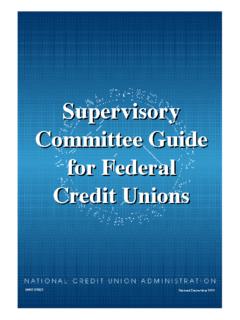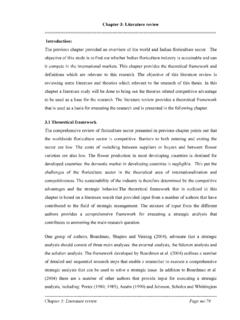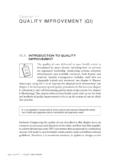Transcription of UNDERSTANDING MIXED METHODS RESEARCH
1 1 CHAPTER1 UNDERSTANDING MIXEDMETHODS RESEARCHWork on this book began almost a decade ago when we startedwriting about MIXED METHODS RESEARCH at the time that quali-tative RESEARCH had achieved legitimacy and writers were advo-cating for its use in the social and human sciences. Since then, we havepublished more than a dozen articles and book chapters on MIXED methodsresearch. However, our own articles, as well as articles written by others, aredifficult to find because they are scattered in many journals and books. Thisis why it is difficult to see the emerging threads of this new say that MIXED METHODS is a new approach, but we recognize thatothers may not see it as a recent approach. Researchers for many years havecollected both quantitative and qualitative data in the same studies.
2 However,to put both forms of data together as a distinct RESEARCH design or method-ology is new. Thus the idea of mixing the data, the specific types of researchdesigns, the notation system, the terminology, the diagrams of procedures,and the challenges and issues in using different designs all topics foundin this book are new features that have emerged within the last , we have new MIXED METHODS RESEARCH designs that stand alongsideexperiments, surveys, ethnographies, case studies, and the many designsavailable to the researcher in the social and human (Designing) 5/16/2006 8:31 PM Page 1 This first chapter addresses A framework for viewing MIXED METHODS RESEARCH A definition of MIXED METHODS RESEARCH , and The importance of this approach, historically and today PURPOSE AND ORGANIZATIONB ecause MIXED METHODS is a new design, researchers need an introductionto the approach, guidance as to how to conduct the design, and informationabout the specific procedures involved.
3 The purpose of this book is to pro-vide researchers with an introduction to MIXED METHODS RESEARCH the process involved in designing and conducting this form of inquiry,and within this process, a focus on four types of MIXED METHODS designsTwo key elements form the central features of this book: the phases inthe process of MIXED METHODS RESEARCH and four specific MIXED methodsdesigns. The process phases advanced in this book build on the prelimi-nary steps that we provided several years ago (Creswell, 1999; Creswell,Goodchild, & Turner, 1996). We have now refined these steps, based on ourexperiences with MIXED METHODS RESEARCH through classes, workshops, andour own MIXED METHODS studies. We recognize that reducing RESEARCH tophases in the process of RESEARCH runs the risk of oversimplifying the proce-dures, suggesting an unwavering, linear approach to RESEARCH .
4 However, weview the process not as a series of lock-step procedures but as a generalframework that might be useful to beginning researchers as well as thosealready conducting and reviewing MIXED METHODS RESEARCH . One might pro-ceed to use the phases in a different order than we present them use themin a way that makes sense for a specific RESEARCH additional focus on four key MIXED METHODS designs also builds onour earlier work (Creswell, 2003; Creswell, Plano Clark, Gutmann, & Hanson,2003). As we have worked with these different approaches to MIXED methodsresearch, we have found that the choice of a type of design to use suggeststhe procedures for collecting and analyzing data and even for writing titlesand purpose statements in present a visual model of the logic of our process approach in As shown in Figure , we divide the phases in the process into individ-ual chapters in this DESIGNING AND CONDUCTING MIXED METHODS RESEARCH01-Creswell (Designing) 5/16/2006 8:31 PM Page 2 Using Figure as our guide, let s assume that a researcher is consideringdesigning and conducting a MIXED METHODS study.
5 We would recommend thatthis individual first develop an UNDERSTANDING of MIXED METHODS RESEARCH to seeif the project fits the type of problems and RESEARCH questions related to mixedmethods ( chapter 1). This might be followed by the researcher s considering acomfortable worldview stance for the RESEARCH and knowing (or reviewing) thebasics of both quantitative and qualitative RESEARCH ( chapter 2). In addition, theinquirer needs to assess whether the RESEARCH problem merits a MIXED methodsstudy ( chapter 2). Following this, the researcher might locate published mixedUnderstanding MIXED METHODS RESEARCH 3 Choose a type ofmixed METHODS designto use ( chapter 4)Locate published mixedmethods studies and reviewhow they are organized( chapter 3)Design an introduction (orstatement of the problem)for the MIXED methodsstudy ( chapter 5)Collect data within amixed METHODS design( chapter 6)Analyze and validate thedata within a MIXED methodsdesign ( chapter 7)Write and evaluate thestudy within a mixedmethods design ( chapter 8)Anticipate MIXED methodsquestions ( chapter 9)Contribute to the mixedmethods literature( chapter 10)Develop an understandingof MIXED METHODS RESEARCH ( chapter 1)Examine preliminary considerations.
6 Identifya worldview stance, review the basics ofquantitative and qualitative RESEARCH , identify aresearch problem, and determine whether it fitsa MIXED METHODS approach ( chapter 2)Figure Used in This Book for Designing and Conducting MIXED METHODS Research01-Creswell (Designing) 5/16/2006 8:31 PM Page 3methods studies and review their organization ( chapter 3). With these prelimi-naries completed, the inquirer is ready to review the various types of mixedmethods designs and select the one that fits the RESEARCH problem ( chapter 4).This design becomes a framework for many aspects of the RESEARCH design, andthe investigator can begin to shape an introduction to the study ( chapter 5), themethods of data collection and analysis (Chapters 6 and 7), the procedures thatwill be used to validate the data ( chapter 7), and the structure of the writing andevaluation of the study ( chapter 8).
7 Finally, researchers need to anticipate thetypes of questions that might be asked about the project ( chapter 9) and tospecify how the study adds to the literature on MIXED METHODS RESEARCH as wellas to the content area under examination ( chapter 10). CLARIFYING TERMSIn discussing the process of RESEARCH , we have already used several terms thatrequire definition. By the overall process of RESEARCH , we mean the proce-dures used in RESEARCH that involve introducing a problem; narrowing theresearch problem into purpose statements, RESEARCH questions, and hypothe-ses; collecting and analyzing data to address these questions and hypotheses;and using a writing structure that best fits the problem and the METHODS . Wefeel that both qualitative and quantitative RESEARCH follow distinct steps in theprocess of inquiry, but they involve executing each phase of the RESEARCH dif-ferently.
8 In chapter 2, we provide definitions for qualitative and quantitativeresearch and note their characteristics. To emphasize quantitative and qualita-tive RESEARCH equally, we will alternate the order in which the two approachesare presented when they arise in each chapter of this book. Also, we will usethe terms investigator(often associated with quantitative RESEARCH ) and inquirer(often associated with qualitative RESEARCH ) is also important before we proceed with a definition of MIXED meth-ods RESEARCH to clarify the distinction between several terms that will be usedthroughout the book: methodology, design, and METHODS . A methodologyrefers to the philosophical framework and the fundamental assumptions ofresearch (van Manen, 1990). Because the philosophical framework one usesinfluences the procedures of RESEARCH , we define methodology as the frame-work that relates to the entire process of RESEARCH .
9 RESEARCH designrefers tothe plan of action that links the philosophical assumptions to specific meth-ods (Creswell, 2003; Crotty, 1998). Experimental RESEARCH , survey RESEARCH ,ethnography, and MIXED METHODS are all RESEARCH designs. METHODS , on theother hand, are more specific. They are techniques of data collection andanalysis, such as a quantitative standardized instrument or a qualitativetheme analysis of text data (Creswell, 2003; van Manen, 1990).4 DESIGNING AND CONDUCTING MIXED METHODS RESEARCH01-Creswell (Designing) 5/16/2006 8:31 PM Page 4 WHAT IS MIXED METHODS RESEARCH ? Some MIXED METHODS writers consider this form of RESEARCH a methodologyand focus on the philosophical assumptions ( , Tashakkori & Teddlie,1998). To call it a methodology introduces a complexity (some would say aneeded complexity) to the process of RESEARCH .
10 Unquestionably, all researchapproaches have underlying philosophical assumptions that guide the METHODS RESEARCH assumes a worldview or several worldviews, a posi-tion that we will advance in more detail in chapter MIXED METHODS writers emphasize the techniques or METHODS ofcollecting and analyzing data ( , Creswell, Plano Clark, et al., 2003; Greene,Caraceli, & Graham, 1989; Onwuegbuzie & Teddlie, 2003). To call mixedmethods RESEARCH a method is clean and concise and resonates with manyresearchers (Elliot, 2005). In this book, we will refer to it as a RESEARCH designwith philosophical assumptions as well as quantitative and qualitative meth-ods. This middle ground seems to provide the broadest definition possible,but it is a definition with a clear focus. Undoubtedly, as a consensus grows asto the meaning of MIXED METHODS RESEARCH , the definition will evolve.
















